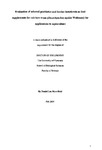Evaluation of selected probiotics and bovine lactoferrin as feed supplements for rainbow trout (Oncorhynchus mykiss Walbaum) for applications in aquaculture
| dc.contributor.author | Merrifield, Daniel Lee | |
| dc.contributor.other | Faculty of Science and Engineering | en_US |
| dc.date.accessioned | 2011-09-22T14:27:07Z | |
| dc.date.available | 2011-09-22T14:27:07Z | |
| dc.date.issued | 2009 | |
| dc.identifier | Not available | en_US |
| dc.identifier.uri | http://hdl.handle.net/10026.1/614 | |
| dc.description.abstract |
A series of investigations were carried out to assessth e intestinal microbiota of rainbow trout and the potential applications of probiotics and bovine lactoferrin (M). Farm and aquarium reared rainbow trout were examined with specific emphasis on the autochthonous microbial communities. Culture-based, culture-independent and electron microscopical investigations revealed mixed, complex microbial communities in all intestinal regions. DGGE based analysis revealed unique species present either only as allochthonous populations or autochthonous populations. 16S rRNA sequence analysis allowed species level identification of a range of isolates, many of which have not been identified from the rainbow trout digestive tract previously. Two ftirther investigations were carried out to assess the potential of using commercial probiotics and bovine Lf on growth, feed utilisation, health and intestinal colonisation of rainbow trout. Standard commercial diets were supplemented with B. subtills, B. licheniformis and Enterococcus faecium either singularly or synergistically. When comparing the findings of the joint study it can be concluded that the application of probiotics with rainbow trout, and likely other finfish species, is highly complicated. Full intestinal replacement of indigenous microbiota is not likely to be a good idea when using E. faecium; the results indicate that a synergistic relationship with the indigenous microbiota is likely to be involved in providing host benefits. Bacillus probiotics only appeared to be effective at high intestinal levels indicating that a synergistic relationship with the indigenous microbiota may not be as important. T'he joint study also indicates that it is not always possible to reproduce probiotic benefits even when using the same probionts, the same fish species and similar rearing conditions. Thus, the physiological status of the fish and the indigenous microbiota are likely to play an important role in the outcome of probiotic administration. A subsequent trial was conducted to evaluate Pediococcus acidilactic! as a probiotic for rainbow trout. The experiment was conducted to supplement the diet with either vegetative cells or lyophilised powder (as commercially provided). Despite successful intestinal colonisation, irrelevant of supplementation form few significant benefits were observed. SEM of the posterior mucosa revealed a localised colonisation pattern of P. acidilactic! between the mucosal folds similar to the observed indigenous microbiota from the farmed fish. This revelation led to a further trial to investigate the nature of probiotic colonisation through the gastro-intestinal tract using electron microscopy. The study confirmed the high colonisation of P. acidilactici on the epithelium of the anterior intestine and posterior intestine. However, it was not possible to observe such colonisation with Bacillus spp. or E. faeclum; despite culture-based results to the contrary. It is likely that the true mucosal colonisation may sometimes be confused with colonisation of the mucus layer as opposed to actual attachment to the epithelium itself. Therefore, it is crucial to utilise electron microscopy in order to confirm epithelial colonisation. The nature of both the indigenous microbiota and the application of probiotics appears to be more complicated than previously thought and continued research is clearly warranted. | en_US |
| dc.language.iso | en | en_US |
| dc.publisher | University of Plymouth | en_US |
| dc.title | Evaluation of selected probiotics and bovine lactoferrin as feed supplements for rainbow trout (Oncorhynchus mykiss Walbaum) for applications in aquaculture | en_US |
| dc.type | Thesis | |
| dc.identifier.doi | http://dx.doi.org/10.24382/4305 |
Files in this item
This item appears in the following Collection(s)
-
01 Research Theses Main Collection
Research Theses Main


